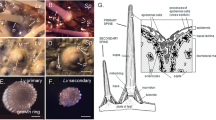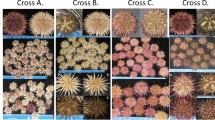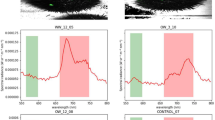Abstract
IT has long been known that certain littoral echinoids habitually cover the parts of their body that are exposed to light by fragments taken from their surroundings. Some have interpreted this as a concealing reaction, or, in part at least, as a response to strong light, or as a defence against desiccation and temperature extremes resulting from exposure at low tide; others remained non-committal. Lytechinus variegatus(Lamarck) shows the response in striking fashion1 and, in Jamaica, in habitats where it is never exposed by tides. The response has been examined in these laboratories.
This is a preview of subscription content, access via your institution
Access options
Subscribe to this journal
Receive 51 print issues and online access
$199.00 per year
only $3.90 per issue
Buy this article
- Purchase on SpringerLink
- Instant access to full article PDF
Prices may be subject to local taxes which are calculated during checkout
Similar content being viewed by others
References
Boone, L., Bull. Bingham Ocean. Coll., 1 (4), 1 (1925). Mortensen, Th., “Monograph of the Echinoidea”, 3, 2, Pt. 1, 433 (Copenhagen, 1943).
Clark, H. L., “Scientific Survey of Porto Rico and the Virgin Islands”, 16, Pt. 1, 81 (New York Academy of Sciences, 1933).
Author information
Authors and Affiliations
Rights and permissions
About this article
Cite this article
MILLOTT, N. The Covering Reaction in a Tropical Sea Urchin. Nature 175, 561 (1955). https://doi.org/10.1038/175561a0
Issue date:
DOI: https://doi.org/10.1038/175561a0
This article is cited by
-
Growth and feeding resilience of green sea urchin (Strongylocentrotus droebachiensis) to visible-light quantity and quality
Marine Biology (2021)
-
Crown-of-thorns starfish have true image forming vision
Frontiers in Zoology (2016)
-
Die Bedeckungsreaktion von Seeigeln. Neue Versuche und Deutungen
Marine Biology (1970)
-
Nachweis von Lichtsinnesorganen bei Seeigeln durch deren Bedeckungsreaktion
Die Naturwissenschaften (1956)



